Coho Salmon Fishing: Guide Tips More Fish
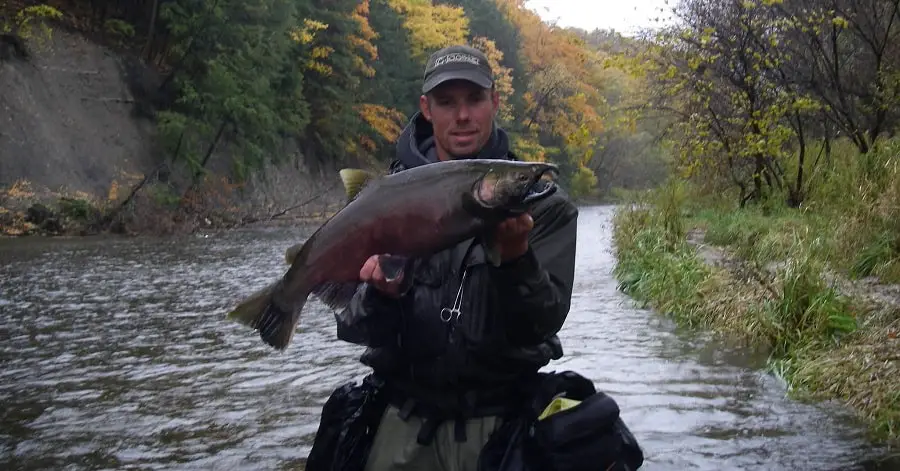
It’s hard to beat Coho salmon fishing since they are plentiful, aggressively attack lures and baits, and are one of the hardest fighting and most acrobatic salmon on the West Coast. This article goes over the tips and tactics and the setups that the experts use when coho fishing.
Let’s dive into the when, where, and how to catch coho salmon both in the rivers and out in the ocean.
What Anglers Should Know About Catching Coho Salmon
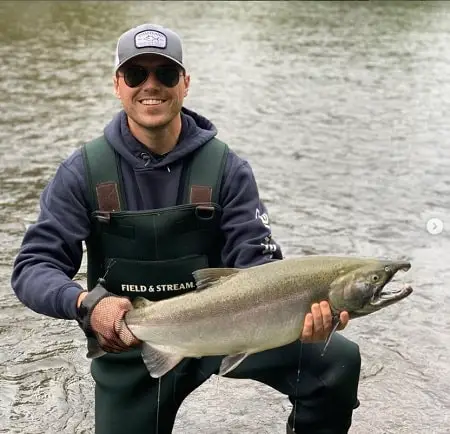
Coho Salmon inhabit the Pacific Northwest Ocean and its tributaries from Alaska to central California.
All of the Great Lakes have been stocked with coho salmon, and the fishing tactics, fishing lures, and baits are very similar.
The current 33.4 pound world record coho was caught on the Salmon River in New York.
The Salmon River NY, is famous for its large runs of Coho and Chinook salmon.
An average Adult coho weighs 8 to 12 pounds and is 24 to 30 inches long. Cohos are also called silvers or silver salmon.
See also, Best Salmon Fishing Destinations in The USA.
What Coho Eat
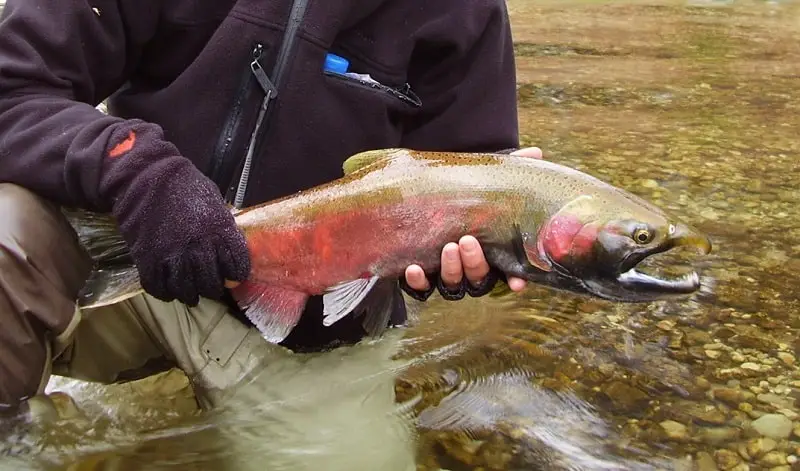
- While in the ocean, coho salmon eat small fishes such as herring, sand lance, anchovies, and sardines.
- When they return to the river for spawning, they will eat the same or similar baitfish, salmon eggs, insects, worms, and often, anything that looks edible.
Spawning Season
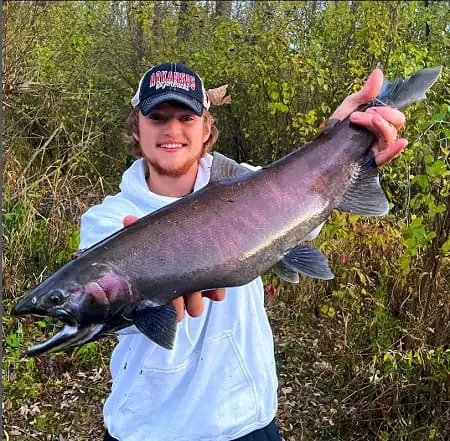
- Coho salmon are anadromous, which means they are born in cold, clean freshwater streams where they spend a year before they migrate out to the saltwater ocean to feed and mature before returning to spawn and die.
- In most areas, Coho will enter rivers river and spawn from September to October. Smaller fish tend to enter the rivers first, with larger fish entering later. Both will bite once they enter the river.
River Fishing For Coho Salmon
Coho salmon fishing in the river is often very different than out in the ocean.
Different methods and baits are used, and in this section, I’ll discuss how to catch coho salmon in rivers.
When To Fish For Coho In Rivers
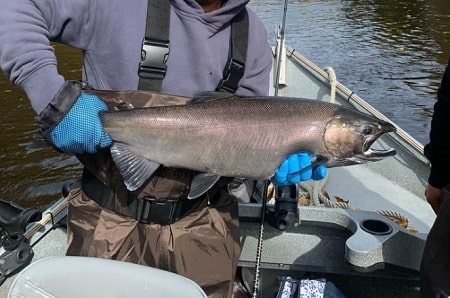
In most southern areas of their Pacific range and in the Great Lakes region, fishermen will start catching the odd coho salmon in the rivers starting in late August. Most fishermen will be targeting coho salmon when the runs are stronger from September through to November.
In Alaska, some rivers will start seeing coho salmon as early as Mid-July, but most rivers peak in August and September, with some running through to late October.
Where To Catch Coho Salmon In Rivers
Coho salmon can sometimes cover hundreds of miles of river. I separate the river into 3 sections and will often fish them differently based on the conditions.
Lower River Coho Fishing
On very large rivers like the Columbia or Fraser River, the lower sections are wide and resemble lakes, and anglers will use tolling methods for catching coho salmon. Shore and bank anglers will also fish deep edges and areas that funnel the coho salmon.
In the lower river, the coho activity and best fishing often peaks during high tides or what is known as flood tide.
On small rivers, the lower river can look more like a trout stream, and fishermen can target coho using typical river fishing methods.
Coho Travel Routes
Once the coho salmon get up the river, I look for travel routes. The salmon often can’t see more than 10 feet in front of them, so they follow currents and the river bottom to navigate up the river.
Based on my experience and how I see it, the salmon point their nose into the current and swim forward, nosing their way up the river. They also use the river bottom to navigate and will often choose to stay on the deeper side of the river rather than the shallower side of the river. That deeper side is a travel route. This may change in very fast and dirty water, which is when they can get really close to shore.
Seams and bubble lines are areas that separate faster water and slow water and these can be travel routes.
I avoid back eddies and boiling water or upwellings.
Coho Holding Water
Holding water is the best water to fish for salmon. Deeper pools, pockets, and spots below rapids all offer slow water and deeper water where the salmon can slow down, conserve energy, and are more likely to bite.
Best River Fishing Methods For Coho
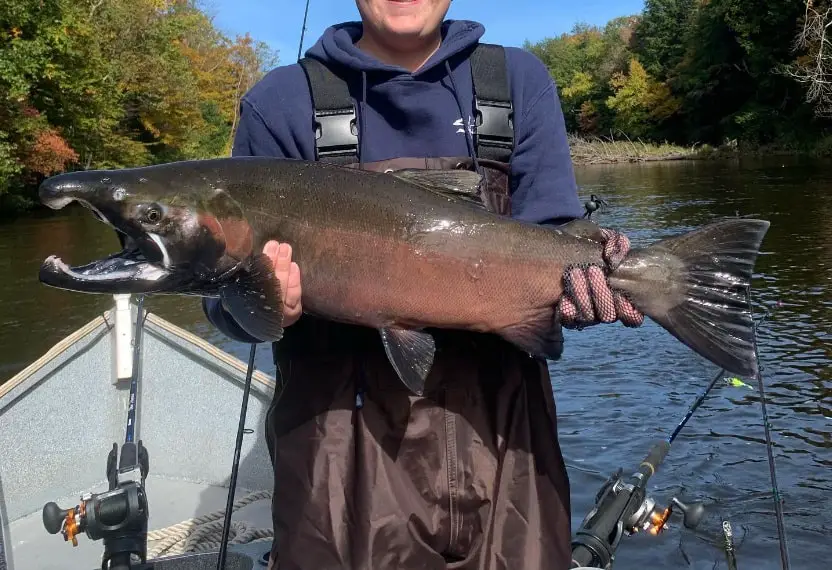
There are many methods that fishermen can use for coho fishing.
Fly Fishing: Fly fishing for coho is effective and fun. Coho can also be caught with streamer flies that imitate baitfish or nymphs that imitate bugs or salmon eggs.
Float Fishing: Float fishing is a great method for targeting coho salmon. Float fishing is when you present a bait below a bobber or river float, and drift the rig down the river with the current. A longer rod is the key.
Drift Fishing: Drift fish methods are an effective way to drift a bait down the river without the use of a float.
Casting Lures: Fishing lures from the bank is a great method for catching coho. Casting lures can can cover a lot of water and be effective for coho and other salmon that migh be in the river at the same time, like chinook salmon and pink salmon. Casting lures is often the best method for fishing frog water. Twitching jigs is also great for river coho.
Plunking For Salmon: Plunking is a still fishing methods where you cast out a heavy weight that anchors your bait or lure near the bottom of the river while the angler waits for a passing coho salmon.
Side Drifting: Side drifting is when you drift down a river in a boat and present a bait beside the boat. You can get very long drifts and cover a lot of water with this method.
Back Trolling: Back trolling is another very effective for targeting coho salmon with lures. Back drifting consists of running multiple lures out of the back of a boat and slowly drifting the boat down towards the salmon.
Mooching For Salmon: Mooching for salmon is a method for coho and chinook salmon where you drop a bait over the side of the boat and reel up, and then drop again. It can be very exciting and effective if done well.
River Fishing Gear
If you have steelhead gear, you already have most of the gear you need for river coho.
Rods: The rod you use will be based on the type of method you want to use. As an example, an 8-foot fast action rod is ideal for twitching jigs, but if you want to float fish, an 11 to 14-foot float rod is best. And for back trolling, a softer rod tip is best.
Reels: Many fishermen will use a spinning reel and spinning rod, but baitcasting reels are good for most methods and ideal for boat fishing. See best reels for salmon HERE.
Line: The line you use will depend on the method you fish. As a general rule, 12 to 20 pound line is good for coho salmon fishing.
Best Lures and Baits For River Fishing
There are a few great lures and a few great baits that consistently catch coho salmon in rivers.
Best Fishing Lures: Spoons, spinners, plugs, and twitching jigs in size from 2 to 4 inches and in a variety of colors is all you need. The more erratic, the better. Since coho salmon are very agressive, they will often hit bright colored lures or dark or black lures so have a good assortment.
Best lures:
- Blue Fox Vibrax sizes 4 and 5. Replace the treble hooks with a single siwash hook.
- Dick Nite Spoons – Spoons are always a good choice.
- Twitching jig – Aerojig Rabbit Salmon Twiching Jig.
- Little Cloe
- Brads Wiggler
- Yakima Bait Mag Lip
Best Baits: Improve your catch rate with a good bait. Chunks of skein, salmon eggs in a sack known as a roe back or spawn sac, prawns, flies, worms, and artificial baits like beads can all be good for coho salmon fishing.
Coho Fishing In The Ocean
For many anglers, catching coho in the open water is the best way of catching coho. There are a few options if you want to do coho salmon fishing in the ocean.
Where To Catch Coho In The Ocean
Summer coho can be way out from shore. Coho tend to bunch up in tide rips, which is anywhere that the surface currents converge. Deep underwater structures also concentrate baitfish like herring, which is where you will find coho.
On cloudy days and mornings, coho will often be higher in the water column, even when it’s over 200 feet deep. Most coho are caught between 10 and 100 feet deep.
Late summer sees coho moving in closer to beeches and shoreline as they stage out from river mouths.
Move Or Not?
It’s funny, one article says don’t leave a spot for more fish and just wait until some coho swim through, and another article says move to locate fish, so which is it?
Holding Coho: In my opinion, based on many years of guiding and fishing for Coho, if a spot is not productive, I move, especially if conditions have the coho holding. I have found spots void of fish and other spots a short distance away full of holding fish.
Migrating Coho: If the coho are on the move, I might stay put and wait. But, even if the fish are on the move, they’ll likely be in many other spots, so moving when you’re not catching is often the best choice.
Try to determine the conditions. If they are favorable for the coho to be on the move, then moving less might be best. But if the water is low, clear, and under bright mid-day sun, they are likely going to hold.
If you’re unsure what the coho are doing, stay if they are biting, and move if they are not biting.
Best Methods For Ocean Fishing
Trolling For Salmon: Trolling for salmon involves using deep diving lures, or a heavy weight, downriggers, or divers to get the lures down to the salmon.
Trolling Speed: Most fishermen and guides will tell you to troll between 2 and 4 mph for coho salmon. However, coho salmon are known to hit when tolling up to 5.5 miles per hour.
What To Troll With: Trolling with a flasher and hoochie or a spoon is very common with most charter boats. You want to troll at a speed that will get the flasher rotating at a good clip. When fishing with cut-bait herring, you want it spinning fast.
Jigging For Salmon: Jigging over the side of the boat is another method used by coho salmon anglers.
Beach Fishing For Salmon: Fishermen without a boat will take advantage of higher tides that push salmon closer to shore. Cohos will get close when they are seeking out their preferred spawning river. Casting lures or casting jigs is popular with beech anglers.
Ocean Fishing Gear
Rods: Long 9 to 11-foot trolling rods are preferred. Use rods that are made for the method you are fishing for. Meaning use downrigger rods, dipsy rods, or trolling rods.
Reels: When trolling and fishing on the ocean, it’s best to know how much line you have out, so most anglers will use line counter baitcasting reels. You want just enough line out to get the desired depth. In some cases, coho will hit a lure 10 feet behind the boat, other times, you will need to get your lure 50 feet down to catch a fish.
Line: Angler will use monofilament lines, lead-core lines, copper lines, and braided lines. 40 to 65 pounds is common.
Net and Release Gear: Get yourself a wide hoop and a long handle net with a deep net bag. Also, be sure you have gloves and long pliers.
Best Lures and Baits For Ocean Fishing
Coho love trolling spoons, hoochies, trolling flies, and cut bait rigs.
Harvesting Tips For Coho Salmon
Harvesting and storing your freshly caught salmon can make a big difference in how well it tastes at the dinner table. Use these charter boat secrets for harvesting salmon:
- Bonk your freshly caught salmon a couple of times on the top of the head hard to kill or stun it.
- Cut the gill or rip the gills on both sides to bleed the salmon out.
- Place the salmon head down in a bucket or hang it off a stringer for about 5 minutes.
- Put the salmon on ice as soon as possible.
If you are a bank fishermen, place the salmon on a stringer and leave it in the water until you leave. Then get it on ice as soon as possible.
7 Gudie Tips For Catching Coho Salmon
- Rotate Colors: Just because you did well one day with bright chartreuse, doesn’t mean that will be the hot lure every time. On sunny days, copper or gold tends to work, but on cloudy days, bright colors and silver can be hot. Rotate though different colors to see what the fish want.
- Rotate Baits: Some days, the coho will crush a straight moving spinner, while other days, a wobbling plug or twitching jigs will hook more fish.
- Rotate Size: Having a selection of sizes that you can change based on river conditions or the salmon’s mood will result in more fish. I use larger lures and bait in dirty water or low light. I will use smaller spoons, crankbaits, or plugs, and smaller baits in clear water or when salmon are holding. I will also choose my lure based on casting distance.
- Cover The Water Effectively: As a guide, I have seen firsthand how poorly most fishermen cover the water, and the result is fewer fish. It is important to get your lure into all areas of the area you are fishing if you want to hook and catch more fish.
- Fish The Right Water: Coho salmon will hold or move through different types of water during their migration. In low clear water, especially during high sun, the salmon will be in the deeper pools. Early morning and at dusk, and early fall, the coho will be moving and can be at the head of pools, pocket water, and in runs. Late fall coho will be further up the river spawning or looking for spawning water, and the lower river will be empty of fish, so follow the salmon through their migration.
- Fish After High Water: In larger rivers, the coho salmon will enter the river at any time becuase there is plenty of current and depth. However, it is common for the salmon to move in during high tide. In smaller low rivers, the salmon will wait for big rains to bring up the water levels before they move into the river.
- Watch The Surface: Both out in the lake and in the river, watch for surface activity from jumping coho which can help you find fish. Coho are known to jump, roll, and boil on the surface, and since they tend to school, when there is one, there is more. Also look for gull activity which an indication of baitfish.
Coho Salmon Fishing Q&A
If you have a question or comment or want to share your tips on coho salmon fishing, let us know in the comments section below.
Tight Lines
Graham

Great source for those of us who are just learning the boat method, having always been a bank guy. If we are fishing the water of the Columbia just outside the Sandy for Coho this October 2024, rain is coming within a couple of days, and we want to be in the best spots this week. Are we best off anchoring a couple hundreds yards downriver or trolling all the way through and past, that is upriver of the Sandy?